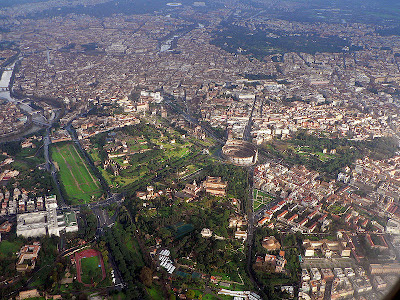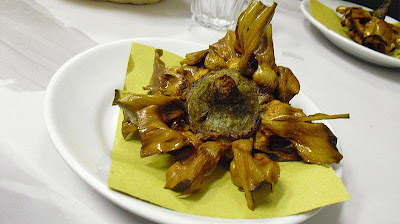Rome – Jewish Artichokes
Rome – the city of visible history, where the past of a whole hemisphere seems moving in a funeral procession with strange ancestral images and trophies gathered from afar.
George Eliot, author.
 |
| Aerial view of Rome By Oliver-Bonjoch (Own work) [CC-BY-SA-3.0 (http://creativecommons.org/licenses/by-sa/3.0) or GFDL (http://www.gnu.org/copyleft/fdl.html)], via Wikimedia Commons |
Rome, a city where the history of centuries sits amongst the accoutrements of modern life, is not a place you can rush. After a week in its environs there will still be more to see – ancient Roman architecture and monuments, the power and glory of the Roman Catholic Church, sculpture that awes and the little gems that seem to pop up around every corner. Wherever you go in Rome be sure to take your imagination with you.
I stood in the Circo Massimo, rising up from behind trees vast arches of brown stone stand on the Palatine Hill as a reminder of Ancient Rome’s glory days. The Circus stretched away from me. Discussions continue as to whether it was large enough for chariot races to be held there. Some think that the cornering would have been too tight and that foot races were a more likely event. Standing in the centre I preferred to imagine the thundering of hooves, the snorting of horses, the creaking of the skin and leather bindings of the chariots and the yells of charioteers as they urged their steeds around the circus to raucous cheers from the crowd. Noise, heat, the smell of straining animals, the sight of man and beast working together to triumph – a far better spectacle than barely clad men running. Until there’s conclusive proof either way, in my mind it will be chariots competing in the circus.
 |
| Circo Massimo viewed from the Palatine Hill Author=Photograph by Greg O'Beirne |Permission=GFDL / Creative Commons |other_versions |
Jews, immigrants and foreigners were not allowed to reside in the city during various times in Rome’s history and the Ponte Fabricio bridge (Pons Judaecum to give it one of its other names) was their commuter route into it from the Trastevere area. A papal bull in the sixteenth century forced the Jews to live in a walled ghetto on the other side of the river to Trastevere and for some three hundred years that is where they remained until the unification of Italy in 1861 allowed them to live freely. Eventually the ghetto was demolished and modern buildings were erected. I found the ghetto to be one of the most charming areas of the city but you have to remember that this is a sanitised version of the area in which the Jews were incarcerated for centuries.
 | ||||||
Arco delle Azimelle in Ghetto, Rome
|
The synagogue that stands in the ghetto is a modern building erected in 1904 on the site of the old synagogue. I wandered along narrow, twisting streets coming across the Piazza Mattei with its Renaissance fountain and along the via del Portico d’Ottavia. It was quite a street with its plethora of kosher fast food joints, food shops and restaurants nestled amongst a mixture of medieval and modern buildings. Many of the eateries offered carciofi alla Guidea, deep-fried Jerusalem artichokes, a speciality of Jewish Rome.
 |
| Carciofi alla Guidia Author=Simone.lippi |Date=2010-04-18 |Permission= GNU Free documentation license |
Recipe
4 medium artichokes (if you can find the ones without thorns and hairy choke it makes preparation easier).
Lots of Olive Oil
Salt
Bowl of water with the juice of a lemon
· Prepare the artichokes. See Hints and Tips as to how this can be done.
· Place each prepared artichoke in the bowl of lemon water until they are all ready. This will prevent any browning of the vegetable.
· Place the artichokes into a pot and cover with water. Simmer over a medium heat for approximately 15 minutes, or until they are tender to the touch of a fork. Drain them and pat them dry.
· In a deep pan heat enough oil to cover the artichokes. The oil should be 300 degrees, hot but not spitting hot. Add the artichokes and fry for about 10-15 minutes until they are golden brown. Remove from the oil.
· Leave them to cool, then separate the leaves out and sprinkle with a little salt before returning them to the hot oil for a couple more minutes to crisp.
· Remove Artichokes from the pan, drain and they are ready to serve.
Hints and Tips
How to Prepare an Artichoke.
This can be a fiddly business but is worth it for the yumminess that follows. Youtube has a host of helpful videos on how to prepare them - take your pick from the list http://www.youtube.com/results?search_query=preparing+artichokes&oq=preparing+art&gs_l=youtube.1.0.0l3.170.3137.0.5206.17.11.2.4.5.0.158.979.9j2.11.0...0.0...1ac.m0cpPfBvqUo
This can be a fiddly business but is worth it for the yumminess that follows. Youtube has a host of helpful videos on how to prepare them - take your pick from the list http://www.youtube.com/results?search_query=preparing+artichokes&oq=preparing+art&gs_l=youtube.1.0.0l3.170.3137.0.5206.17.11.2.4.5.0.158.979.9j2.11.0...0.0...1ac.m0cpPfBvqUo


Comments
Post a Comment